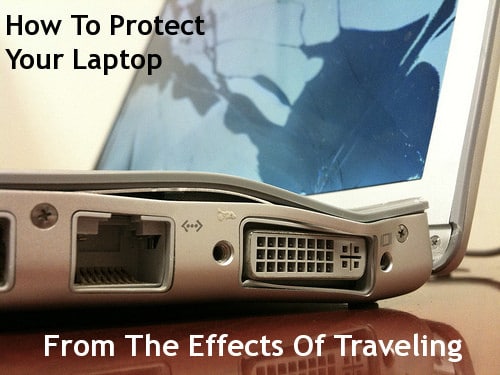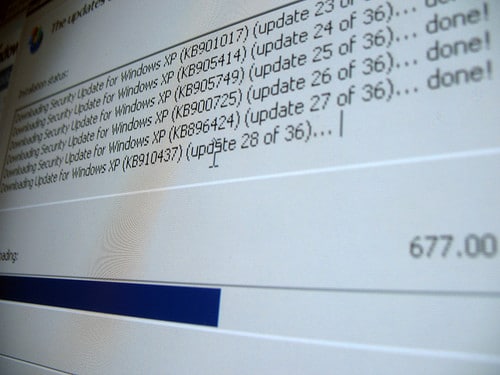After a few days or weeks of traveling it can be relaxing to take a day off and pop open your laptop lid – except when you find it’s sluggish, screaming incomprehensible warnings, and in a general state of crankiness. Traveling can be rough on a laptop, especially since we tend to neglect their needs until our bouncing backpacks finally come to a halt.

You can avoid a bad case of travel laptop by getting your computing companion prepared for the road and giving it a bit of tender care along the way.
 Update Before You Leave Home
Update Before You Leave Home
Most people, whether traveling or not, tend to put off software updates as long as they can; a big cause of computer sluggishness. You can get away with it for a while, that is, until all of your programs are begging for their latest versions in unison, leaving you with a frustratingly slow machine.
- Focus On The Operating System – Make sure to install the most critical updates at a minimum. Both Windows and Mac OS X are good about differentiating between important and optional updates.
- Update Domino – Often when there is an update to an operating system like Windows, other software developers issue updates to keep up. (You may have noticed with updates, when it rains it pours.) It’s best to keep everything on the same page for optimal performance.
- A Few Days Before Departure – There is a perception that updates are more trouble than their worth, which isn’t true most of the time. Just to be on the safe side however, install your operating system updates (here’s how on Windows and Mac) a few days before leaving home.
The first thing you should do with your laptop when returning from a trip is to run major software updates. I know you’re excited to email, Twitter, and Facebook your friends about your trip to Germany but the longer you hold off on software updates, the further they’ll accumulate to make your laptop feel like its from 1998.
 Get A Second Laptop Case
Get A Second Laptop Case
Even a good padded day-pack isn’t sufficient insulation for your laptop. Between the bouncing around in your backpack and the touch of the floor each time you set it down, a traveling hard drive takes a soft but sustained beating. A laptop case that fits around your portable device inside of your backpack will prolong its life and the little bits of data in the hard drive as well.
- Look For Specifics – Cases built for a particular laptop model tend to be more snug making them easier to pull out and put back into your travel bag.
Also, don’t forget that you’re carrying around a sensitive, albeit portable, piece of technology. Be gentle when stuffing your laptop back in your bag after a long security line, and when running through the airport to catch a flight.
Be Weary Of The Weather
Extreme heat can not only shorten battery life, it can also reduce your laptop’s longevity by causing internal parts to expand, potentially damaging them.
 Don’t Keep Your Laptop On Your Lap – Ironic I know, but your thighs don’t allow for the best airflow and transfer heat.
Don’t Keep Your Laptop On Your Lap – Ironic I know, but your thighs don’t allow for the best airflow and transfer heat.- Monitor The Temperature – Try iStat for Mac or Real Temp for Windows; both free downloads.
- Cold Can Actually Be Worse – Low temperatures make moving parts (like those inside your hard drive) much more rigid and breakable.
- Stay Within The Recommended Range – Temperatures between 10-35 Celsius (50-95 Fahrenheit) are acceptable for most laptops.
- Dust, Sand, And Smoke – The tiny particles of these elements can easily make it into the crevices of your laptop, accumulating over time. Dirt tends to get stuck around the vents (reducing airflow) and optical drives causing them to die well before their time. Avoid using your laptop outside in dusty environments, on beaches, or in smoky rooms.
Ideally you want to wait to use your laptop until you’re somewhere near room temperature and you’ve given it a chance to adjust before turning it on. Don’t use your laptop in extreme temperature conditions or when the relative humidity is above 75%.
 Shutting Down And Other Travel Protections
Shutting Down And Other Travel Protections
Most newer laptops have sleep modes that let you power up your laptop quickly after opening the lid. They work by keeping memory (RAM) chips running at low power which increases heat and may require your hard drive to be accessed from time to time.
Your data is most vulnerable when your hard drive is spinning so when transporting it, shut it down or use hibernate mode (built into Windows and can be enabled on Mac).
- Never Carry Your Laptop When It’s On – Before jumping around to a better table in a coffee shop, close your laptop lid and make sure it’s either shut down, in sleep mode, or hibernating. Remember, your data is most vulnerable to knocks and bumps when in use.
- Turn Off Offline When Online – Google Gears lets you use Web tools services like Gmail, Google Calendar, and Google Docs when you don’t have an Internet connection. It’s a great tool, except when you’re back online – Google Gears often gets confused and sync-crazy – to calm it down turn offline mode off, then back on.
- When In Doubt Reboot – A clean slate clears up many wonky-laptop issues, even on Mac.
Perhaps the best precaution is having a good backup of your data offline somewhere physically separate from yourself. One of two free online backup options is Crashplan, a personal favorite. (Here’s how to create a free offline backup system with Crashplan.) Those of you who might need to recover quickly from a dead laptop or are working from the road should consider cloning your system. Finally, take special care to protect you digital photos and physically lock down your laptop to keep it secure while traveling.
[photos by: ismh_ (smashed laptop), lunchtimemama (Windows update), welshkaren (man holding laptop case), SashaW (woman enduring heat), notemily (cat sleeping on laptop)]












Great tips! Don’t forget your antivirus software and personal firewall, especially on Windows. My Windows XP laptop got infected with a virus in Hong Kong. Machine slowed to a crawl and became completely unusable.
I had to reinstall the operating system. I got it done, but those are hours I could have been out exploring as opposed to looking for drivers to put back on my laptop.
Good point and definitely two pieces of software that should be kept up to date always. It’s best to have them auto-update for those times when it’s so tempting to skip them 🙂
There’s a couple of ways to fix these issues.
First, if you want hassle free software, including not worrying about viruses: Get Linux. Specifically, get something user friendly like Ubuntu. There’s even a version specifically for netbooks. It comes with a software center that lets you download thousands of software for free, all made by the community. The core of Ubuntu and its software all have automatic upgrades. Again, hassle free.
Ubuntu also has a low footprint on your laptop/netbook’s resources. It’s lightweight, meaning it can bring new life to your older machine.
Second, if you want to travel and be able to backup your data, I would go with an external hard drive. It gives you extra storage for all those pictures you’ll take and helps protect your data. I’ll be taking one with my netbook when I start traveling next month. My netbook has an SSD (Solid State Drive) meaning it has no moving parts. It’s small, so thats the other reason for the external HD.
Disclaimer: This comment is in no way shape or form a diss towards windows or mac. Both are great operating systems. But when it comes to viruses, windows is probably the worst IMHO.
Hope this helped!
The only thing I don’t like about carry the external HD along is that is doesn’t account for if something happens to your bag and both laptop and drive are taken. I’m a bit (well, more than a bit) on the paranoid side and like having the data offline as well.
I only learnt about the “don’t move around if your laptop is asleep and not off” tip this week. I just bought a new computer (my first Mac) and glad to learn this now and not in a few months after traipsing around with a whirring hard drive.
I currently use an external hard drive and time machine on my Mac backs up to it, but it still worries me because if the laptop is stolen, chances are the hard drive would be too. Any suggestions for online backup solutions?
Great post, as always!
I am a big fan of Crashplan:
http://b2.crashplan.com/landing/index.html
You can set it up for free on any number of computers (like a friends, or your parent’s at home) and use them as secondary storage sites. Here’s a walk-through:
http://www.techguidefortravel.com/2010/06/29/how-to-use-crashplan-to-create-a-free-robust-and-online-backup-system/
Or, you can get unlimited offline backup on the Crashplan servers for $125 for 3 years. Personally, I use their family plan to backup multiple laptops for $180/3 years.
Perhaps you are writing for someone making a short trip, but I see no reason not to have the auto-update feature turned on (at least, for Windows systems). With the ready availability of good Internet connections in so many places, you are surely going to have the time to install any relevant updates even while traveling.
True, but most people will probably prolong the (often) mandatory reboots or skip the updates all together when on shorter trips and Internet time may be limited or competing with travel time. They’d rather just pop open their computer, email, Skype, and chat rather than wait the 3 minutes for updates to complete.
Good point, but I have found that it is usually the case with Windows updates that they will get downloaded to the computer and you can then delay the actual installation until you are offline. I myself am endlessly annoyed with mandatory restarts, but that is the price for choosing Windows and, fortunately, I have noticed that more and more frequently the updates DON’T require a reboot.
Anil you’re always full of such brilliant advice. Each week I continue to be shocked! It makes complete sense not to move your laptop with the HD working away, something I’ll take note of moving forward.
I think I treat my Mac pretty well, but as an interesting aside – I read this post, Stumbled it, Tweeted it, and just as I was getting ready to comment Firefox stopped responding as did the rest of my programs. I actually had to do a hard restart which is extremely rare. A sign I need to start treating my baby better?!
Thank you very much for the kind compliment Matt, I sincerely appreciate it.
As for your recent problem, I’d bet it has more to do with Firefox than you Mac. It tends to hog resources over time and get especially cranky when a plugin needs updating. When you restarted, did it by any chance install and add-on updates? Also, sometimes FF doesn’t always shut down completely and you have to Force Quit from the Apple menu – it might help you avoid the system restart in the future.
I’m really guilty of carrying my laptop around with the cover open. I remember when I first got it, reading that it should not be moved, and being so careful with it. But over time, I’ve gotten more reckless. So far no problems, but your post is a good reminder to be more gentle.
It’s so tempting sometimes, especially when the move is a quick or short one 🙂
Great tips! I cringe when I see people walking around with their laptops running, or worse, their external hard drives. Asking for trouble!
Heat will definitely shorten the life of your notebook. Use a table people, your bank account will thank you.
Wish they would make external drives clear – if people could see how delicate the internal parts and spinning disk (not to mention how close everything is together), they might be more careful 🙂
I have traveled with my laptop for almost 15 years. I use one of those foamy neon colored Incase sleeves and then pack it into the center of my oversize briefcase/overnight carry one bag. Works wonders, as I can take it out at my destination or on the plane and it’s still protected while I’m getting orgainzed.
One note: NEVER use your computer on a table that has a table cloth without checking if you computer “is a bottom breather” especially outside on a hot day. I totally ruined an old Mac laptop that way–overheated the fan, it stopped and then so did the computer ;-( Lesson learned!!!
Macs are notoriously bad at dissipating heat and best to be extra careful with them, good tip 🙂
I just bought a new laptop and I am excited to carry it around with me on my upcoming excursions. Thanks for these great tips, I’m going to do all I can to make it last as long as possible. Appreciate you sharing that link for monitoring the temperature using iStat.
You’re very welcome, enjoy the laptop!
Great tips for keeping laptops in good running order while traveling. I always put my Mac to sleep and close the lid before moving it around. Also, don’t forget to back up important files on a thumb drive as you work on them. Crashes do happen. Don’t loose all your stuff in the process.
…and crashes always seem to happen at the worst times! Well, guess there never really is a “good” time for it…
Some great thoughts. I tend to run a quick security/virus scan on my return to make sure all is OK.
A great idea, especially when visiting parts of the world where viruses are more prevalent.
Thanks for the tips. I know about the the cold. I live in Canada, and one winter day (a very very cold one), I left my laptop in my trunk. And even though it had a case and was inside a laptop bag, the mechanics or graphics became really shoddy for a long time…My Mac got frost bite, I think! LOL!
It’s cold up there!!
Great info – never thought that much about temperature before. Have a few follow up quesitons:
-for a Mac – is putting it in sleep mode good enough when you are transporting it? I’ll turn it off if I’m going to not use it for a while, but for shorter day trips I simply put in sleep…wondering if that’s good enough?
-If you monitor the temperature and it says it’s getting too hot – what can you do to keep that from happening?
Thanks Anil!
Hi Sherry, to answer your questions:
Sleep is OK for quick moves across a room but when transporting (especially in the heat) hibernate is a better alternative. Here’s a widget that enables it on Mac and only adds a second or two to the start up as opposed to sleep mode:
http://deepsleep.free.fr/
For the heat, one thing you can do to reduce it is to not run processor-intensive applications. Programs like Photoshop put the processor to work, heating it up quickly. Also, shut down any programs you aren’t using to help keep the temperature in check in hot environments.
You can see what programs are the culprits with Mac’s built-in “Activity Monitor”. Using Spotlight, type “Activity Monitor” and you’ll get a list of all the running programs and how much of the CPU they are using. Shut down any you don’t need when things are running hot.
Hope this helps, if not let me know!
I got a Pogoplug. An awesome piece of kit which ensures my precious photos are backed up at home on my own personal cloud. There’s no operating fees and you can attach as many drives to it as you see fit. If anything happens to my gear at least my memories are safe…
Also I ditched the laptop as a traveling companion and went for an iPad. Sure it’s not as powerful but it’s lighter and fils all the roles I need it to when I’m on the hoof.
Hadn’t heard about the Pogoplug before and just checked it out. Good alternative if you don’t have an old computer lying around. How easy is it to set up and manage?
Very, very easy. I’m a bit useless with computers but I had it set up in less than 5 minutes and I use it loads. I tried it out on a trip to London, snapped loads of photos, uploaded to the iPad then sent them home. Worked an absolute treat! Can’t recommend it enough.
Thanks for the great tips. I will definitely start shutting down my computer when I move it around instead of just closing the lid. I don’t put my computer on my lap, but my boyfriend does so I will have to scold him every time he does it now. 🙂
Oops, hope I didn’t get him in trouble! Well, it’s actually better, studies have shown the heat from the laptop can reduce sperm counts:
http://news.cnet.com/Study%20Laptop%20heat%20a%20threat%20to%20fertility/2100-1044_3-5485763.html